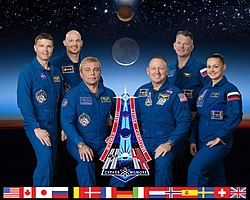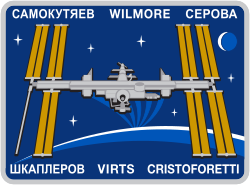Expedition 41
| Expedition 41 | |||
 | |||
| Uppdragsstatistik | |||
|---|---|---|---|
| Rymdstation: | ISS | ||
| Start: | 10 september 2014[1] | ||
| Slut: | 10 november 2014[1] | ||
| Antal besättningsmedlemmar: | 6 st | ||
| Rymdpromenad | |||
| Antal rymdpromenader: | 3 st | ||
| Total tid: | 16 timmar, 25 minuter | ||
| Transport | |||
| Uppskjutning: | med Sojuz TMA-13M, Sojuz TMA-14M | ||
| Uppskjutningsplats: | Kosmodromen i Bajkonur | ||
| Landning: | med Sojuz TMA-13M, Sojuz TMA-14M | ||
| Landningsplats: | Kazakstan | ||
| Kronologi | |||
| |||

Expedition 41 var den 41:e expeditionen till Internationella rymdstationen (ISS). Expeditionen började den 10 september 2014 då delar av Expedition 40s besättning återvände till jorden med Sojuz TMA-12M.
Aleksandr M. Samokutjajev, Jelena Serova och Barry E. Wilmore anlände till stationen med Sojuz TMA-14M den 26 september 2014.
Expeditionen avslutades den 10 november 2014 då Maksim Surayev, Gregory R. Wiseman och Alexander Gerst återvände till jorden med Sojuz TMA-13M.
Besättning
| Position | Första delen (10 - 26 september 2014) | Andra delen (26 september - 10 november 2014) |
|---|---|---|
| Befälhavare | Hans andra rymdfärd | |
| Flygingenjör 1 | Hans första rymdfärd | |
| Flygingenjör 2 | Hans första rymdfärd | |
| Flygingenjör 3 | Hans andra rymdfärd | |
| Flygingenjör 4 | Hennes första rymdfärd | |
| Flygingenjör 5 | Hans andra rymdfärd | |
Referenser
- ^ [a b] NASA's Space Station Expedition 41 Arkiverad 16 augusti 2019 hämtat från the Wayback Machine., läst 3 september 2016.
Externa länkar
| |||||||||||||||||||
Media som används på denna webbplats
The Expedition 41 crew members have released their patch and have written some text to go along with it:
- "Portraying the road of human exploration into our vastly unknown universe, all elements of the Expedition 41 patch build from the foundation, our Earth, to the stars beyond our solar system. The focus of our six-month expedition to the International Space Station (ISS) is Earth and its inhabitants as well as a scientific look out into our universe. The distinguishing ISS solar arrays reach onward and serve as the central element, with the icon of an atom underneath representing the multitude of research onboard that will bring new discoveries for the benefit of humanity. The sun is rising over Earth's horizon, spreading its light along the road of human exploration. Equipped with the knowledge and inspiration gained from ISS, our successful multinational cooperation will lead human space exploration to the moon, Mars, and ultimately, the stars. We are Expedition 41. Join us for the adventure."
Expedition 41 crew members take a break from training at NASA's Johnson Space Center to pose for a crew portrait. Pictured on the front row are Russian cosmonaut Maxim Suraev (left), commander; and NASA astronaut Barry Wilmore, flight engineer. Pictured from the left (back row) are NASA astronaut Reid Wiseman, European Space Agency astronaut Alexander Gerst, Russian cosmonauts Alexander Samokutyaev and Elena Serova, all flight engineers.
The Expedition 40 patch depicts the past, present, and future of human space exploration. The crew wrote the description that follows: The reliable and proven Soyuz, our ride to the International Space Station (ISS), is a part of the past, present, and future. The ISS is the culmination of an enormous effort by many countries partnering to produce a first-class orbiting laboratory, and its image represents the current state of space exploration. The ISS is immensely significant to us as our home away from home and our oasis in the sky. The commercial cargo vehicle is also part of the current human space exploration and is a link to the future. A blend of legacy and future technologies is being used to create the next spacecrafts which will carry humans from our planet to destinations beyond. The sun on Earth's horizon represents the new achievements and technologies that will come about due to our continued effort in space exploration.
The rectangular-shaped design portrays the International Space Station orbiting planet Earth with its solar array wings spread wide. Facing the sun with the lower left outboard solar array feathered, the left array portrays a prominent number "4" and the fully deployed arrays on the right form the Roman numeral version of "2," which signifies the two increment crews which, together, comprise the six-member international Expedition "42" crew. The crew and all supporting personnel around the world are also represented by the six stars adorning the sky around the complex.






